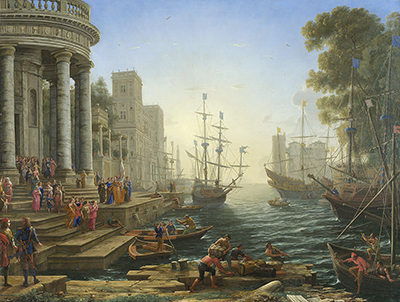Seaport with the Embarkation of Saint Ursula is a 1641 artwork by Claude Lorrain. It can be found in the collection of the National Gallery in London, UK, and is joined there by a number of other paintings by this artist.
Within this scene we find an abundance of classical architecture, most of which lines the left hand side of the painting. There are some stunning marble pillars, towers and a number of steps leading down to the harbour side. Then we have a variety of vessels, including small fishing boats nearest to us, and also some much larger ships. Further buildings line the perimeter of the harbour, with light coming in across the horizon. The sky is blue and bright, with relatively little detail within it. Tall trees can be found to the right hand side, bringing a touch of nature alongside the flickering water which laps around the feet of the figures in the foreground. Lorrain lived much of his life in Rome and this feels to be a strong influence upon this painting, though with mythological themes also being layered on top. This would be the formula that he followed for several decades and helped him to enjoy a list of notable patrons on an international scale towards the end of his career.
Ursula was a Christian princess who travelled to Rome on a pilgrimage, or so according to the story. Seaport with the Embarkation of Saint Ursula there captures the moment after her stay here, in which she prepares to return back to Britain. She stands on the bank, dressed in a golden yellow outfit whilst holding a large flag. Many locals have gathered to wish her well on this long journey, and it was rare for Claude to include quite so many figures within a single painting. Sadly, the group would be attacked on their way home whilst stopping off in Germany, and eventually Ursula herself would be murdered, because of her refusal of a marriage request. Despite the doom which awaits the travelling party, Seaport with the Embarkation of Saint Ursula is a decidely calm artwork, featuring soft light which brightens from the background, as well as a seascape with unthreatening waters. The danger that they faced on the journey would be on land in Cologne, rather than at sea.
The National Gallery hosts this piece alongside a number of other famous Claude paintings. The artist became particularly popular with British collectors some years after his death and this led to a number of artworks appearing within British collections before eventually arriving in public galleries across the country. This particular piece has a connection to the UK through the significance of Brittany and Britain within the story of Ursula. Related artworks to be found in the same gallery include A Seaport, Landscape with Aeneas at Delos, Seaport with the Embarkation of the Queen of Sheba and also Landscape with Hagar and the Angel. The love for landscape painting which exists across the UK makes this artist particularly important, because of the strong legacy that he left which opened the door for other specialists in this genre to follow on afterwards.




